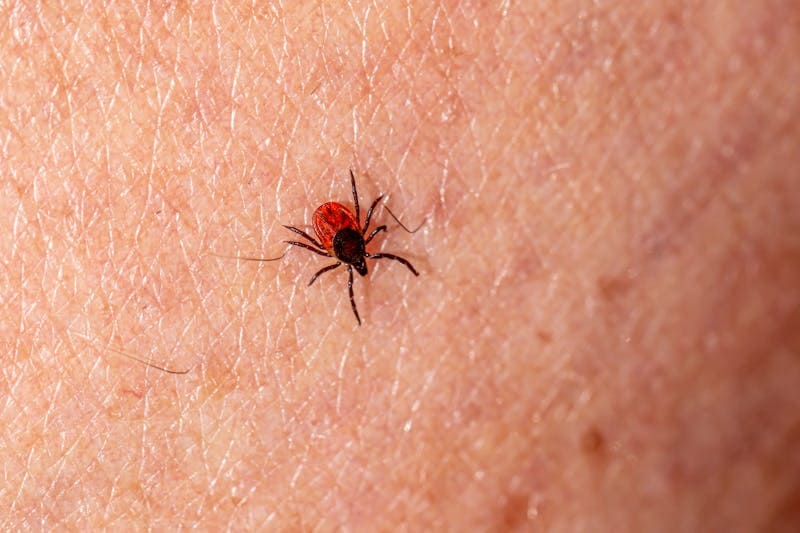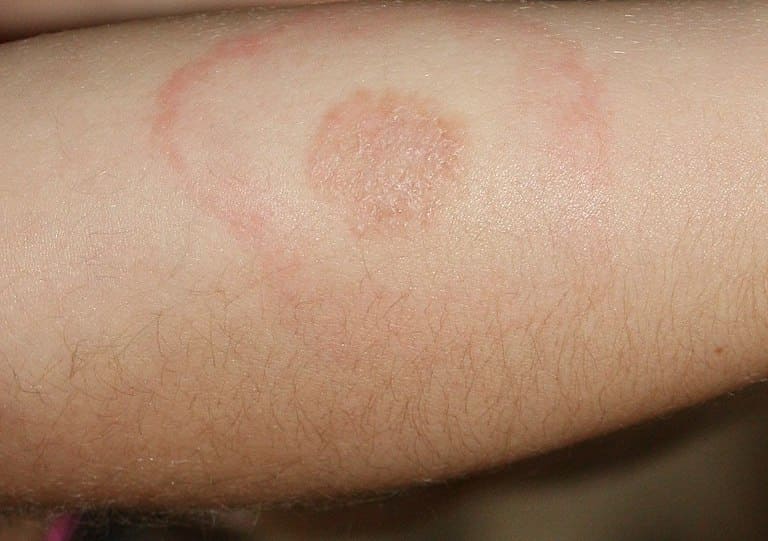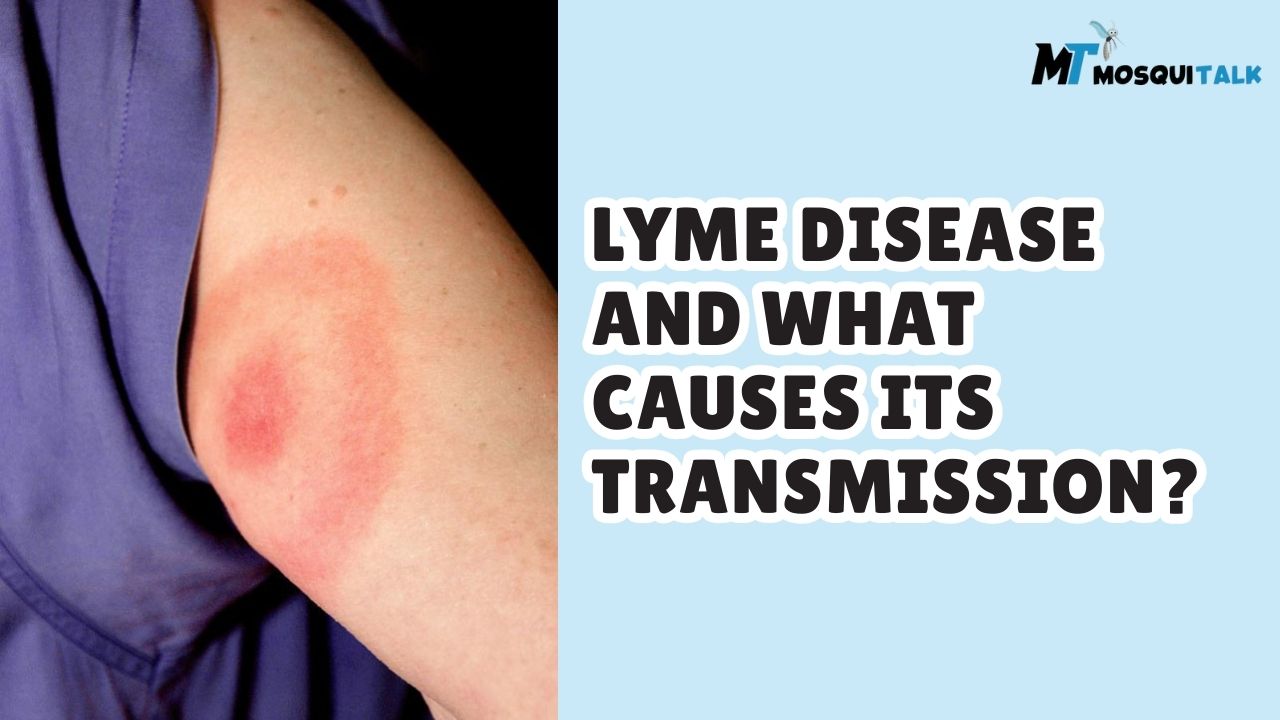Do mosquitoes carry Lyme disease?
According to health experts, you cannot get Lyme disease from mosquitoes. Such an incorrect belief exists because both mosquitoes and ticks are classified as disease-carrying vectors, although they harbor different microorganisms. More precisely, Lyme disease is caused by a germ called Borrelia burgdorferi and is spread only by the bites of infected black-legged ticks also called deer ticks.
Such understanding is important in order to know what actions to take in order to avoid or minimize risk to Lyme disease, especially when going out in the countryside.

Image Credit: Pexels by Erik Karits

Image Credit: Wikimedia by Ltshears
What is Lyme Disease and What causes its Transmission?
Definition of Lyme Disease
Lyme disease can be described as a disease affecting humans and is caused due to infection and is accompanied by fever, headaches, fatigue, and a specific type of skin lesion called a rash which is characterized by circular border areas with a clearer center and is known as erythema migrans. If not given medical treatment, the infection can result in serious, health problems including joint pain or even affect the nervous system of an individual.
How ticks influence the spread of certain diseases?
Ticks can be classified as parasites which since their nature have to feed off the blood of some host. For a black-legged tick to an append to a host an individual has to wait for a few hours, otherwise there would a failure in the transmission of the Borrelia bacteria.
These infections caused due to the appendage can be caused owing to the extended duration the appendage spends in one spot. Mosquito bites on the other hand last for a shorter duration which results in the Lyme disease pathogens not being transmitted effectively.
Reasons why mosquitoes cannot be classified as vectors for Lyme disease
Every piece of evidence points to the fact that there is no possible transmission via Mosquito.
Borrelia has been discovered in the salivary glands of some mosquitoes, however, there the possibility of being bitten by such mosquitoes that would be able to transfer the Borrelia to a host during a single bite is not high. This is what consistently shows without any doubt that Lyme disease has not got any chance to be sexually transmitted via mosquitoes.
To support these statements, the CDC has stated that “Lyme disease is transmitted through the bite of infected black-legged ticks and not human-biting mosquitoes; and that these ticks do not carry the Borrelia burgdorferi flagella in the first place.
Research Findings
Mosquito bites were examined as a possible source and vector for the Borrelia causative agent, however, it appears that laboratory mice experiments showed there was no success in virus transmission. Furthermore, Lyme disease tended to show increases in prevalence in the spring and summer when the tick population was at its peak rather than during the summer where mosquito bites tend to be most rampant.
Distinguishing Between Vector-Borne Diseases
Vector Types: Ticks vs. Mosquitoes
Both mosquitoes and Ticks are considered vectors around the world and although they share the acronym there ability to vector pathogens is quite different.
- Ticks: Vectors responsible for the transfer of the pathogen which causes Lyme disease, the pathogen which is responsible for Rocky Mountain spotted fever and pathogens that lead to developing the disease anaplasmosis.
- Mosquitoes: Pathogen vectors of the malaria parasite,dengue fever virus, Zika virus, and West Nile Virus.
Every vector type has its own technique of transmitting the pathogens around the body, Ticks for instance transmission involves blood feeding that does take some time while mosquitoes can transmit pathogens rapidly around the body due to their feeding motion when being attacked.
Preventing Mosquitoes and Tick Bites
It is crucial that measures are taken to avoid getting exposed to Ticks due to their one and only sole contender that facilitates transmission of the Lyme disease, here are a couple of measures to avoid getting bitten by ticks:
- Wear Protective Gear: Use of long pants along with clothes that cover the entire body can help reduce exposure of the skin.
- Use Insect Repellent: Ensure that skin and clothing contains permethrin or DEET based insect repellants.
- Perform Tick Checks: When engaging in chores that require you to work outside, ensure that you check your body and remove ticks if any are found.
- Yard Maintenance: Ensure that the grass is clipped and decayed leaves are cleaned so that ticks do not reproduce.
📰 Must Read,
✔️ How to Keep Mosquitoes Away While Camping?
✔️ Can We Use Coffee Grounds as Mosquito Repellent?
Conclusion
To summarize, Lyme disease cannot be caught from a mosquito bite as it is only passed through an infected tick, hence there is no need to be afraid of a mosquito bite, however precaution measures against tick bites do remain important. Such knowledge makes it clear how a person may contract Lyme disease, therefore avoiding specific situations, along with taking specific measures while engaging in outdoor activities significantly decreases the chances of acquiring this illness.
So instead of worrying over ticks, you can focus on not receiving any mosquito bites, allowing you to spend time outside in a more relaxing, yet fun way.
Frequently Asked Questions (FAQs)
What should I do if I find a tick attached to my skin?
Immediately removing a tick from any part of the skin is essential since it decreases the probability of getting Lyme disease and activating other tick-borne illnesses. It is worth noting that ticks have to be attached to the body for a period exceeding twenty-four hours to effectively transmit Lyme disease, hence the removal becomes imperative.
Tick Removal Process
- Required Materials: Tweezers with fine tips, rubbing alcohol, soap, and water will be required in the procedure.
- Sanitizing Supplies: Infection can be prevented by cleaning the tweezers with rubbing alcohol, preparing them for use.
- Grasp the Tick: Tick Gripping Tweezers can be used in holding the tick as close to the skin as possible especially the mouth or head area of the tick.
- Pull Upward: Firm and steady pressure should be applied with the aim of pulling upwards and in the process avoiding jerking movements or twisting of the tick. This ensures that the mouth components do not break and stay embedded inside the skin.
- Clean the Area: Washing the hands, and the area around the biting spot with soap and water, or rubbing alcohol but this is done only after step four.
- Tick Disposal: Alcohol or tape can be used to place the tick in a secured container or bag, and if symptoms occur later on the tick is helpful as a form of identification.
After the Removal, What’s Next
- Look out for Symptoms: Check the affected areas for rash, fever, or body ache, and see if any other symptoms of Lyme disease appear during the next couple of weeks after the tick bite.
- Contact a healthcare provider: If you experience any symptoms after removing the tick within a span of 30 days, it is recommended to consult a healthcare professional while stating your recent tick bite to them.
To minimize the risk of Lyme disease from the ticks it is essential to follow the steps above to ensure all proper care is taken after the encounter with a tick.
How long do ticks need to be attached to transmit Lyme disease?
For Lyme disease to be effectively transferred by ticks, it must stay attached to the host for at least 24 hours. Some reports however, claim that a minimum attachment period of 36 hours is preferable. Getting ticks off one’s body at the earliest becomes paramount. The earlier a tick is removed, the less susceptible one is to Lyme disease and other tick borne illnesses. Should any of the following be experienced i.e. fever, rashes or sore joints within a month from the tick bite, a medical professional should be approached without delay and one must inform them about the tick bite.
What are the signs that a tick bite has become infected?
Symptoms that could indicate that the tick bite has been infected includes an increase in the inflammation or swelling associated with the site of the bite, heat as well as hurt. It may be accompanied by pus or some form of discharge, which are tell-tale signs of an infection. More general and systemic manifestations may appear such as high temperature, excessive sweating, weakness, muscle soreness, and headaches. These symptoms should be evaluated, particularly if they follow a tick bite and appear a couple of days to weeks after, and a physician should be consulted for further assessment and treatment.
How can I tell if a tick has been attached for more than 36 hours?
One tick that has been attached to someone’s body for a long time might be difficult to determine due to its small size as well as being ignored. In general, an engorged tick looks darker and larger than an unengorged tick. Therefore, if the colour of the tick has changed considerably or has started to bloat a bit more, it might be a sign that it has been sucking blood for a longer time than needed. Regardless, it would be hard to explain if that tick, during the attachment was observed or not as for confirming whether it has been on for longer than 36 hours would be difficult to define.
Am I obligated to take prophylactic antibiotics post a tick bite?
People say it’s a good idea to take prophylactic antibiotics if, for example, they live in a region prone to Lyme disease and the tick was on them for more than 36 hours. The recommendations of a healthcare provider should include the use of antibiotics advised only after all factors relevant such as tick type, total duration of attachment, and individual health history factors. For people who meet these criteria, a single course of doxycycline can be endorsed to inhibit the onset of Lyme Disease.
First step if impossible to remove tick completely?
If you’re unable to remove a tick completely, and only part of it remains lodged in your skin, then wash the area with soap and warm water to reduce the risk of infection. It is necessary to get medical help for the removal of any remaining parts of the tick from your skin, and also to evaluate the person for any signs of disease infection and/or transmission. They can provide instructions about looking for symptoms of tick-based illnesses and other similar diseases.
How do I preserve a tick while ensuring its safe transport for examination?
One may store a tick for testing while ensuring its safe transport by first killing it. This can be achieved by placing it in rubbing alcohol or perhaps freezing it in a bag. One is then able to put the tick in alcohol. After a tick has been killed it can ice in a container or a bag when the tick has been killed. You will also require some moisture, such as a damp paper towel. Label the container with the date alongside the location of the bite for future resource. If you want to send it for testing, local nursing clinics should provide specific instructions on submission.

